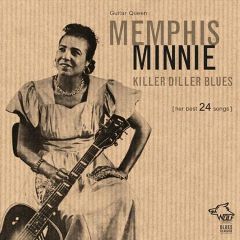Memphis Minnie – Killer Diller Blues (2018)
Memphis Minnie – Killer Diller Blues (2018)

1: Bumble Bee 2: Memphis Minnie Jitis Blues 3: Plymouth Rock Blues 4: New Bumble Bee 5: Frankie Jean 6: Crazy Cryin' Blues 7: Where Is My Good Man 8: My Butcher Man 9: Hustlin' Woman Blues 10: Doctor, Doctor Blues 11: Hoodoo Lady Blues 12: Down In The Alley 13: I Hate To See The Sun Go Down 14: Has Anyone Seen My Man? 15: Nothing In Rambling 16: In My Girlish Days 17: Me And My Chauffeur Blues 18: This Is Your Last Chance 19: I Am Sailin' 20: Fashion Plate Daddy 21: Moaning Blues 22: Killer Diller Blues 23: Down Home Girl 24: Kissing In The Dark Memphis Minnie – guitar, vocals
Although highly-regarded by those in the know, it is perhaps surprising that Memphis Minnie is not better known. Born Lizzie Douglas in Algiers, Louisiana, on 03 June 1897, Minnie was a fabulous singer, a sharp songwriter and a magnificent finger-style guitarist. She recorded over 200 songs in a career that lasted from the 1920s to the 1950s. She played with the likes of Willie Brown (author of “Future Blues” and friend and musical partner of both Charley Patton and Robert Johnson) and slide guitar wizard, Casey Bill Weldon, to whom she was also briefly married in the 1920s. She was also an innovator, being one of the first blues players to use a steel-bodied National guitar in 1929, and playing an electric wood body National and various other electric guitars in the 1940s.
Killer Diller Blues is a collection of 24 tracks from across Minnie’s career from the esteemed Austrian blues record label, Wolf Records. It is possible to distinguish three clear strands to her musical evolution through her recording career, and the CD contains representative tracks from each era. Her initial recordings with her second husband, Kansas Joe McCoy in the late 1920s and early 1930s (here represented by seven tracks, including the classic “Bumble Bee”) were essentially acoustic guitar duets. This led on to the more sophisticated swing band sound of the late 1930s and early 1940s where she played with the likes of pianist Black Bob, mandolin player Charlie McCoy and drummer Fred Williams. Killer Diller Blues contains six songs from this era, including “I Hate To See The Sun Go Down” which borrows heavily from WC Handy’s earlier “St Louis Blues”. The third phase began around 1941, when she started playing with Little Son Joe on second guitar, often with a stand-up bass and drums. Minnie’s single note lines on tracks like “Moaning Blues” and “Down Home Girl” augured and influenced the subsequent electric stylings of Jimmy Rogers and Johnny Shines.
The sparse liner notes to the CD, written by Hannes Folterbauer, are perhaps most notable for incorrectly referring to Willie Brown as “Henry Brown” and for repeating the story from Big Bill Broonzy’s autobiography about a cutting contest between Broonzy and Minnie in Chicago in 1933 for the prize of a bottle of wine and a bottle of gin. Broonzy wrote that Minnie won the prize by playing “Me and My Chauffeur Blues” and “Looking the World Over”. As noted by Paul and Beth Garon, however, in their excellent Woman with Guitar: Memphis Minnie’s Blues, this story at best is an amalgamation of different contests, since both of the songs alleged to have been played by her date from the 1940s rather than the 1930s. Indeed, “Me and My Chauffeur Blues” borrows the melody of Sonny Boy Williamson’s “Good Morning, School Girl”, itself only from 1937. Killer Diller Blues contains Minnie’s 1941 recording of “Me And My Chauffeur Blues” but sadly does not include “Looking The World Over” (later magnificently covered by BB King on his My Kind Of Blues album).
Given the sheer number of songs Minnie recorded during her career, there will always be room for healthy debate as to what are her best 24 songs. Obvious omissions include “When The Levee Breaks” (yes, that is where the Led Zeppelin song comes from), “What’s The Matter With The Mill?” and “Black Rat Swing”. With excellent remastering by Fabian Wessely at Soundborn Studio, however, the tracks on Killer Diller Blues are certainly a fine introduction to one of the indisputable all-time blues greats and Wolf Records are to be congratulated on another fine reissue. ---Rhys Williams, bluesblastmagazine.com
download (mp3 @320 kbs):








